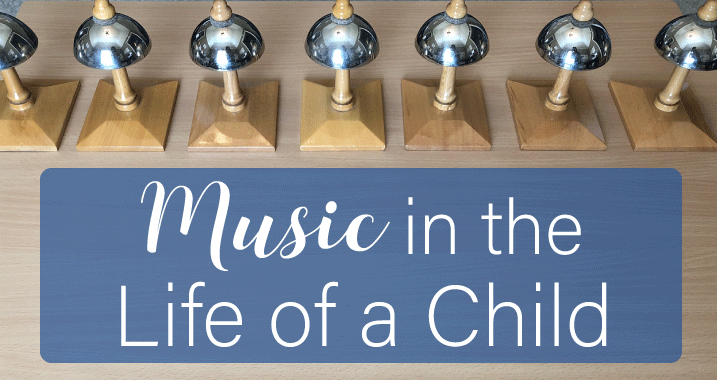One thing that is a constant throughout my day, is music! It is all around us: our homes, cars, stores, church services, gyms, amusement parks, outdoors events, etc. Music is powerful! It can change our mood, relax us or energize us. Maria Montessori understood the important and value of music.
“…There should be music in the child’s environment, just as there does exist in the child’s environment spoken speech. In the social environment the child should be considered and music should be provided.” -Maria Montessori
Maria’s son, Mario Montessori compared the growth of music in a child to their ability to learn language: “The child does not learn language, he absorbs it as a dry sponge absorbs water. Language seems to grow in the child. Given the chance music can also grow in the child as he himself grows.” -Mario Montessori, Man’s Spiritual Expressions: Language and Music.
Music should be a daily experience and enjoyed numerous times throughout the day. In traditional schools setting music is usually limited to a special class taught once or twice a week. To develop an appreciation of music and to truly enjoy it, the adults in the child’s environment must realize the value of music. It is truly a joyful experience that can encourage a shy child to “come out of his or her shell” and the aggressive child to become more cooperative and calm.
Music experiences begin with just exposing the child to instrumental music while they work in the classroom or during lunch and naptime. Try various styles of music such as classical or soft jazz. Just remember that music is more than listening to other’s compositions or performances! For children music can be an opportunity for creative self- expression and a release of their emotions. Through the use of simple rhythm instruments and bells, children can create their own music and be introduced to the basic elements of music such as tempo, dynamics, rhythm and the solfege. The adult in the classroom needs to have a basic understanding of the elements of music in order to expose and guide the child in their music experiences and appreciation. In our Montessori environments, music should be given the same respect as Math and Language!
There has been numerous research studies on the effects of music on children. One study at the University of Windsor was conducted with Montessori students. The results determined that children who received music enriched Montessori instruction were in the 90th and 99th percentiles, in mathematics evaluations compared to other students who received limited music enrichment in their Montessori classrooms. “The program was sequenced to teach concepts of pitch, dynamics, duration, timbre, and form as well as skills in moving, playing, listening, singing and organizing sound.” (Maureen Harris, Montessori Mozarts)
Once you understand the importance of music in the child’s environment, you need to create meaningful musical experiences for the child. The following are a few that I have used in my classroom for years:
1) Daily listening to instrumental music while working and napping. Each month you should introduce the students to one of the great composers and listen to their music throughout that month.
2) Music and Movement Experiences. My favorite is Johnette Downing’s recordings, The Second Line - Scarf Activity Songs. A quick download for your phone or ipad! My top three are Scarves Up and Down and Around (Calming Effect), Water, Wind and World (Calming Effect) and an energizing activity, Rhythm in the Scarves.
3) Musician and Montessorian, Frank Leto has a great collection of children’s music! Songs for Special Days, Songs for Quiet Times, Move Your Dancing Feet, Time for Music II, Songs for Circle Time and Rhythm Band Jam, are all in my collection! His recordings introduce echoing lyrics to gain skills in reproducing melodies and rhythms. Just listen and repeat…..so easy!
4) Montessori Minute Melodies by Shelley Murley is wonderful. Each song is only a minute and uses lyrics with beautiful melodies to introduce the names of the continents, oceans, time, coin values, and so much more. This is a great resource to play and sing along to at any time of your day……any time you have a minute! This one is also an available for download.
5) The Montessori bells, should not be over looked. Though I have found that fewer schools have these, perhaps due to the cost, around $1000. If you do have these wonderful bells in your environment, there are many You Tube videos that you can view to get some quick and easy instruction.
6) 101 Rhythm Instrument Activities for Young Children, by Abigail Flesch Connors, contains many tried and true rhythm activities for small children that I have used throughout the years.
7) Montessori Services has a beautiful set of miniature musical instruments and matching picture cards that are a great source for your shelves as an individual activity.
The above list is really just a beginning. In my formal educational experience, I minored in music and obtained my state teacher’s license to teach music through middle school, but you really do not need that in order to give the child wonderful early childhood experiences in music.
Just take the time to enjoy and experience music with the children in your life!

